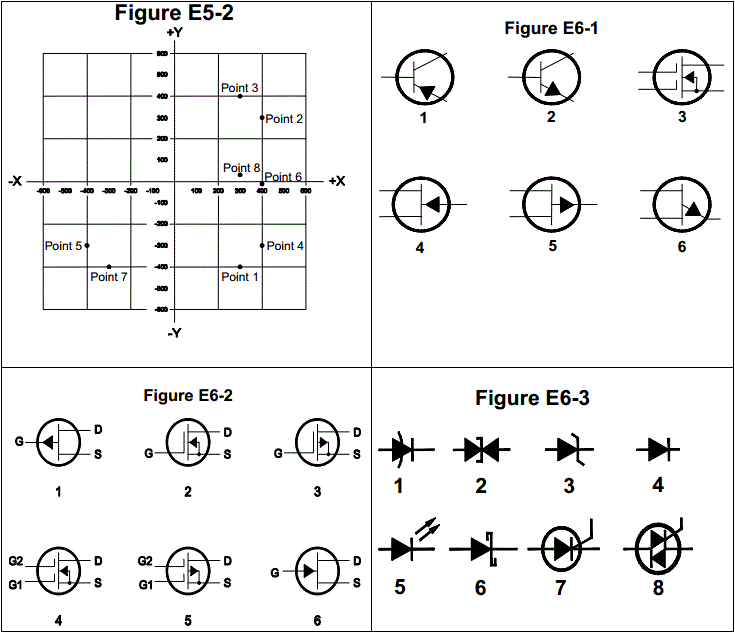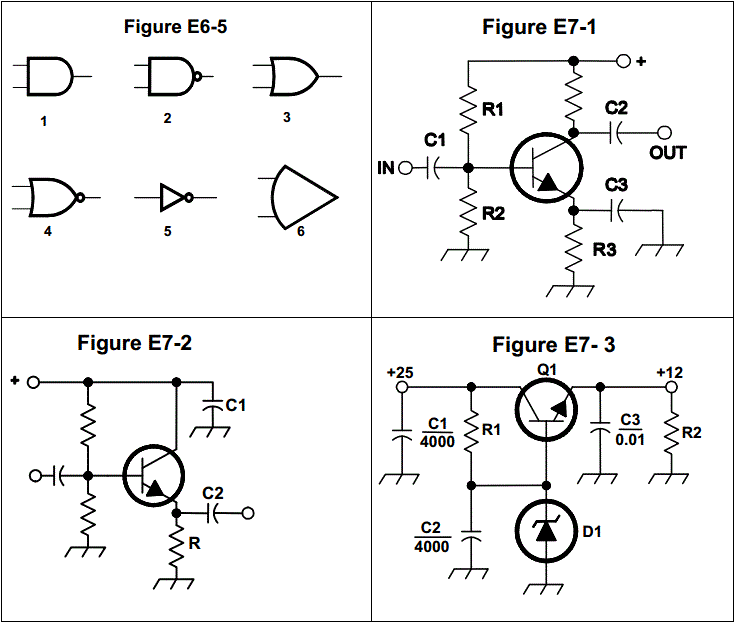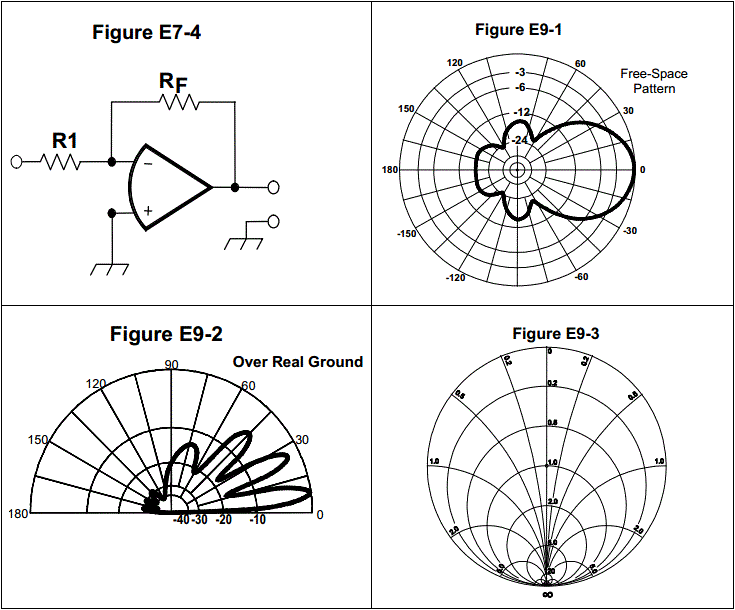Ham Extra License Practice Quiz
• Percentage: 0%; Correct: 0; Total: 0 of 50
E0A06: Why are there separate electric (E) and magnetic (H) field MPE limits?
The body reacts to electromagnetic radiation from both the E and H fields
Ground reflections and scattering make the field impedance vary with location
E field and H field radiation intensity peaks can occur at different locations
All of these choices are correct
E1A07: What is the only amateur band where transmission on specific channels rather than a range of frequencies is permitted?
12 meter band
17 meter band
30 meter band
60 meter band
E1B06: Which of the following additional rules apply if you are installing an amateur station antenna at a site at or near a public use airport?
You may have to notify the Federal Aviation Administration and register it with the FCC as required by Part 17 of FCC rules
No special rules apply if your antenna structure will be less than 300 feet in height
You must file an Environmental Impact Statement with the EPA before construction begins
You must obtain a construction permit from the airport zoning authority
E1C06: Which of the following statements concerning remotely controlled amateur stations is true?
Only Extra Class operators may be the control operator of a remote station
A control operator need not be present at the control point
A control operator must be present at the control point
Repeater and auxiliary stations may not be remotely controlled
E1D02: What is the amateur satellite service?
A radio navigation service using satellites for the purpose of self training, intercommunication and technical studies carried out by amateurs
A spacecraft launching service for amateur-built satellites
A radio communications service using amateur radio stations on satellites
A radio communications service using stations on Earth satellites for public service broadcast
E1E02: Where are the questions for all written US amateur license examinations listed?
In FCC Part 97
In a question pool maintained by the FCC
In a question pool maintained by all the VECs
In the appropriate FCC Report and Order
E1F06: What is the National Radio Quiet Zone?
An area in Puerto Rico surrounding the Aricebo Radio Telescope
An area in New Mexico surrounding the White Sands Test Area
An area surrounding the National Radio Astronomy Observatory
An area in Florida surrounding Cape Canaveral
E2A09: What do the terms L band and S band specify with regard to satellite communications?
The 23 centimeter and 13 centimeter bands
The 2 meter and 70 centimeter bands
FM and Digital Store-and-Forward systems
Which sideband to use
E2B12: How are analog SSTV images typically transmitted on the HF bands?
Video is converted to equivalent Baudot representation
Video is converted to equivalent ASCII representation
Varying tone frequencies representing the video are transmitted using PSK
Varying tone frequencies representing the video are transmitted using single sideband
E2C08: Why are received spread-spectrum signals resistant to interference?
Signals not using the spectrum-spreading algorithm are suppressed in the receiver
The high power used by a spread-spectrum transmitter keeps its signal from being easily overpowered
The receiver is always equipped with a digital blanker circuit
If interference is detected by the receiver it will signal the transmitter to change frequencies
E2D06: Which of the following is a commonly used 2-meter APRS frequency?
144.39 MHz
144.20 MHz
145.02 MHz
146.52 MHz
E2E09: Which of the following HF digital modes uses variable-length coding for bandwidth efficiency?
RTTY
PACTOR
MT63
PSK31
E3A10: Which of the following is a good technique for making meteor-scatter contacts?
15 second timed transmission sequences with stations alternating based on location
Use of high speed CW or digital modes
Short transmission with rapidly repeated call signs and signal reports
All of these choices are correct
E3B04: What type of propagation is probably occurring if an HF beam antenna must be pointed in a direction 180 degrees away from a station to receive the strongest signals?
Long-path
Sporadic-E
Transequatorial
Auroral
E3C13: What type of polarization is best for ground-wave propagation?
Vertical
Horizontal
Circular
Elliptical
E4A06: Which of the following could be determined with a spectrum analyzer?
The degree of isolation between the input and output ports of a 2 meter duplexer
Whether a crystal is operating on its fundamental or overtone frequency
The spectral output of a transmitter
All of these choices are correct
E4B08: Which of the following is a characteristic of a good DC voltmeter?
High reluctance input
Low reluctance input
High impedance input
Low impedance input
E4C13: How does a narrow-band roofing filter affect receiver performance?
It improves sensitivity by reducing front end noise
It improves intelligibility by using low Q circuitry to reduce ringing
It improves dynamic range by attenuating strong signals near the receive frequency
All of these choices are correct
E4D01: What is meant by the blocking dynamic range of a receiver?
The difference in dB between the noise floor and thelevel of an incoming signal which will cause 1 dB of gain compression
The minimum difference in dB between the levels of two FM signals which will cause one signal to block the other
The difference in dB between the noise floor and the third order intercept point
The minimum difference in dB between two signals which produce third order intermodulation products greater than the noise floor
E4E14: What is one type of electrical interference that might be caused by the operation of a nearby personal computer?
A loud AC hum in the audio output of your station receiver
A clicking noise at intervals of a few seconds
The appearance of unstable modulated or unmodulated signals at specific frequencies
A whining type noise that continually pulses off and on
E5A15: What is the resonant frequency of a series RLC circuit if R is 56 ohms, L is 40 microhenrys and C is 200 picofarads?
3.76 MHz
1.78 MHz
11.18 MHz
22.36 MHz
E5B04: What is the time constant of a circuit having two 220-microfarad capacitors and two 1-megohm resistors, all in parallel?
55 seconds
110 seconds
440 seconds
220 seconds
E5C01: In polar coordinates, what is the impedance of a network consisting of a 100-ohm-reactance inductor in series with a 100-ohm resistor?
121 ohms at an angle of 35 degrees
141 ohms at an angle of 45 degrees
161 ohms at an angle of 55 degrees
181 ohms at an angle of 65 degrees
E5D13: How much power is consumed in a circuit consisting of a 100 ohm resistor in series with a 100 ohm inductive reactance drawing 1 ampere?
70.7 Watts
100 Watts
141.4 Watts
200 Watts
E6A08: What term indicates the frequency at which the grounded-base current gain of a transistor has decreased to 0.7 of the gain obtainable at 1 kHz?
Corner frequency
Alpha rejection frequency
Beta cutoff frequency
Alpha cutoff frequency
E6B08: Which of the following describes a type of semiconductor diode?
Metal-semiconductor junction
Electrolytic rectifier
CMOS-field effect
Thermionic emission diode
E6C04: Which of the following is the primary advantage of tri-state logic?
Low power consumption
Ability to connect many device outputs to a common bus
High speed operation
More efficient arithmetic operations
E6D06: What core material property determines the inductance of a toroidal inductor?
Thermal impedance
Resistance
Reactivity
Permeability
E6E01: What is a crystal lattice filter?
A power supply filter made with interlaced quartz crystals
An audio filter made with four quartz crystals that resonate at 1-kHz intervals
A filter with wide bandwidth and shallow skirts made using quartz crystals
A filter with narrow bandwidth and steep skirts made using quartz crystals
E6F12: What absorbs the energy from light falling on a photovoltaic cell?
Protons
Photons
Electrons
Holes
E7A04: How many flip-flops are required to divide a signal frequency by 4?
1
2
4
8
E7B10: In Figure E7-1, what is the purpose of R1 and R2?
Load resistors
Fixed bias
Self bias
Feedback
E7C04: How does an impedance-matching circuit transform a complex impedance to a resistive impedance?
It introduces negative resistance to cancel the resistive part of impedance
It introduces transconductance to cancel the reactive part of impedance
It cancels the reactive part of the impedance and changes the resistive part to a desired value
Network resistances are substituted for load resistances and reactances are matched to the resistances
E7D01: What is one characteristic of a linear electronic voltage regulator?
It has a ramp voltage as its output
It eliminates the need for a pass transistor
The control element duty cycle is proportional to the line or load conditions
The conduction of a control element is varied to maintain a constant output voltage
E7E13: Which of the following describes a common means of generating an SSB signal when using digital signal processing?
Mixing products are converted to voltages and subtracted by adder circuits
A frequency synthesizer removes the unwanted sidebands
Emulation of quartz crystal filter characteristics
The quadrature method
E7F11: What is an advantage of a period-measuring frequency counter over a direct-count type?
It can run on battery power for remote measurements
It does not require an expensive high-precision time base
It provides improved resolution of low-frequency signals within a comparable time period
It can directly measure the modulation index of an FM transmitter
E7G11: What absolute voltage gain can be expected from the circuit in Figure E7-4 when R1 is 3300 ohms and RF is 47 kilohms?
28
14
7
0.07
E7H11: What are the major spectral impurity components of direct digital synthesizers?
Broadband noise
Digital conversion noise
Spurious signals at discrete frequencies
Nyquist limit noise
E8A01: What type of wave is made up of a sine wave plus all of its odd harmonics?
A square wave
A sine wave
A cosine wave
A tangent wave
E8B06: What is the deviation ratio of an FM-phone signal having a maximum frequency swing of plus or minus 7.5 kHz when the maximum modulation frequency is 3.5 kHz?
2.14
0.214
0.47
47
E8C05: What is the necessary bandwidth of a 13-WPM international Morse code transmission?
Approximately 13 Hz
Approximately 26 Hz
Approximately 52 Hz
Approximately 104 Hz
E8D11: What is the average power dissipated by a 50-ohm resistive load during one complete RF cycle having a peak voltage of 35 volts?
12.2 watts
9.9 watts
24.5 watts
16 watts
E9A13: How much gain does an antenna have compared to a 1/2-wavelength dipole when it has 6 dB gain over an isotropic antenna?
3.85 dB
6.0 dB
8.15 dB
2.79 dB
E9B06: If the boom of a Yagi antenna is lengthened and the elements are properly retuned, what usually occurs?
The gain increases
The SWR decreases
The front-to-back ratio increases
The gain bandwidth decreases rapidly
E9C01: What is the radiation pattern of two 1/4-wavelength vertical antennas spaced 1/2-wavelength apart and fed 180 degrees out of phase?
A cardioid
Omnidirectional
A figure-8 broadside to the axis of the array
A figure-8 oriented along the axis of the array
E9D11: What is the function of a loading coil as used with an HF mobile antenna?
To increase the SWR bandwidth
To lower the losses
To lower the Q
To cancel capacitive reactance
E9E09: Which of these matching systems is an effective method of connecting a 50-ohm coaxial cable feed line to a grounded tower so it can be used as a vertical antenna?
Double-bazooka match
Hairpin match
Gamma match
All of these choices are correct
E9F06: What is the approximate physical length of an air-insulated, parallel conductor transmission line that is electrically one-half wavelength long at 14.10 MHz?
15 meters
20 meters
10 meters
71 meters
E9G09: What third family of circles is often added to a Smith chart during the process of solving problems?
Standing-wave ratio circles
Antenna-length circles
Coaxial-length circles
Radiation-pattern circles
E9H05: What is the main drawback of a wire-loop antenna for direction finding?
It has a bidirectional pattern
It is non-rotatable
It receives equally well in all directions
It is practical for use only on VHF bands



